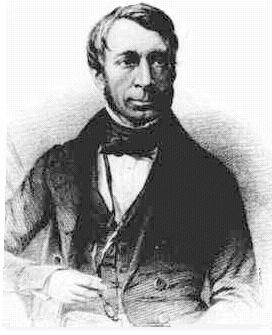|
|
THE
RADIUS
VECTOR:
A ‘TRIVIAL’
QUESTION?
 Following
Adams’ abortive visit in late October, Airy wrote to Adams
on November 5th 1845 and put the question: Following
Adams’ abortive visit in late October, Airy wrote to Adams
on November 5th 1845 and put the question:
'I shall be very
glad to know whether the assumed perturbation will explain the error
of the radius vector of Uranus. This error is now very considerable
.. ' and he referred Adams to ‘the Greenwich observations for
each year.’ Why did Airy want to know this, and was his question
merely ‘trivial’, as Adams in 1883 told Glaisher? Accounts
have tended to endorse the latter view, by way of explaining why
Adams never replied to Airy’s letter.
Each year the Nautical
Almanac, published from Greenwich, gave predicted planetary
positions, including the logarithm of the radius vector of Uranus
(called, ‘The Georgian’) to eight-figure accuracy. This
was given every day, in two columns, one heliocentric and the other
geocentric: five thousand digits a year, from Greenwich about Uranus’
distance. As the value only changes slowly through the years, the
purpose of giving daily computations remains opaque. One is amazed
by such useless labour, baffled by the spurious orders of magnitude
of these figures, and perplexed as to how the daily distance values
were obtained. Later, Astronomical Observations made at the Royal
Observatory noted the daily position of Uranus, together with
(rather enigmatically) Airy’s computed ‘Error of tables’
indicating the perceived anomaly. Adams was being asked to comment
on these observations.
In 1836, Airy had
published in the Astronomische Nachrichten, a calculation
showing how Uranus was then further away than it should have been,
according the Bouvard’s tables. (1838,
Vol.15, 217-220, using observations 1833-36).
It was, Airy had found, too far by about five-thousandths of an
AU, which is quite a small amount, and he believed that to be significant.
Over the course of a year one obtained a value of this distance,
by a parallax method which compared Uranus’ geocentric longitude
on the two occasions when Earth and Uranus were in square to the
Sun. Adams, wanting to engage in discussion with Airy, would be
familiar with this publication, as well as the high orders of magnitude
to which Airy’s workers were, every day of every year, citing
Uranus’ radius-distance.
Adams notebooks
show him continuing to grapple with this issue after Airy put the
question, until finally on September 1st he obtained
a value similar to that published by Airy, for the 1830s. This concordance
with Airy’s empirically-found data was stated both in his September
2nd letter and at his RAS presentation.
Airy always viewed
the question he had put as crucial:
‘I therefore
considered that the trial, whether the error of the radius vector
would be explained by the same theory which explained the longitude,
would be truly an experimentum cruces,’
he explained to
the RAS on November 13th. His view was however mistaken,
in the view of most commentators, eg Turner (1904):
‘The ‘error
of the radius vector’ came before Airy in an entirely independent
way, and as an entirely independent phenomenon, from the ‘error
of longitude’, and there was nothing unnatural in regarding
it as requiring independent explanation. It is true that, as
the event proved, a mere readjustment of the orbit of Uranus
got rid of this error of the radius vector (this was substantially
Le Verrier’s answer to Airy’s question). (Astronomical
Discovery, p.58)
Uranus was in these
years approaching its apogee, so that its distance or ‘radius
vector’ was continually increasing. Uranus lagging behind its
predicted position would thereby diminish its radius vector, whereas
the reverse viz. an increase was what required explaining. The theory
involved was succinctly explained in Airy’s textbook Gravitation
(1834). Airy there described how, during a planetary conjunction,
as between Jupiter/Saturn or Uranus/Neptune, the outer planet pulls
upon the inner one:
‘The effect
then of a force in the direction of a planet’s motion, which
increases the planet’s velocity, is to increase the size of
its orbit.’
The inner planet
(Uranus) has its orbit increased due to the transfer of angular
momentum, as increases its potential energy, and this process is
then reversed after the conjunction. Airy thus saw the problem in
terms of Newtonian physics. (The perturbation-effect worked mainly
twenty years or so either side of the Uranus-Neptune conjunction,
say 1800-1840. The calculations of Adams and Leverrier only became
feasible in the aftermath of this event, they could not have been
done earlier.) Adams’ commented to Airy (November 18th,
1846) as to why he had not thought the matter was of much importance.
Airy in his livid (and long-censored) letter of December 8th
to Sedgwick merely said:
‘I do not enter
into any details about Adams’ notion that the examination of
the effect of the radius vector was unimportant. It now suffices
for my guidance that I thought it important and still think so.
Perhaps it might be sufficient for your persuasion, to tell you
that Leverrier also thought it important.’
The issue is far
from resolved, and a reconstruction using modern equations would
certainly help. |
